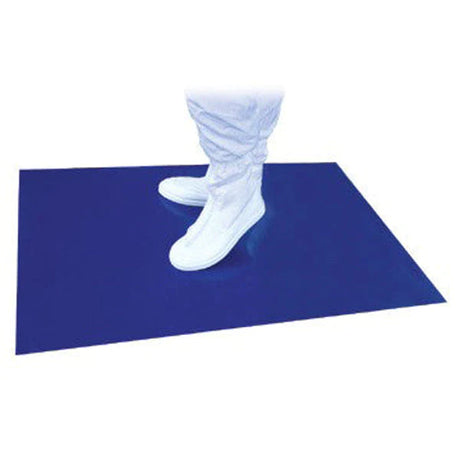- No products in the cart.
In laboratory environments, precision and cleanliness are of paramount importance. Tacky mats, also known as sticky mats or adhesive mats, play a crucial role in maintaining a contamination-free workspace by trapping dirt, dust, and particulates from footwear and equipment. As the top layer of a tacky mat accumulates debris over time, it becomes essential to determine the optimal frequency for peeling and replacing this layer. In this comprehensive guide, we will explore the factors that influence the decision-making process and provide insights into establishing the ideal frequency for peeling the top layer of a tacky mat in laboratory settings.
Understanding Tacky Mats and Contamination Control
Tacky mats are multi-layered adhesive mats strategically placed at entry points to controlled environments such as laboratories, cleanrooms, and manufacturing facilities. These mats are engineered to capture particulates, preventing their transfer into critical areas. As individuals step on the mat, contaminants adhere to the sticky surface, reducing the risk of cross-contamination.
Factors Influencing Peeling Frequency
The optimal frequency for peeling the top layer of a tacky mat depends on a range of factors, each contributing to the overall cleanliness and efficiency of the laboratory environment.
1. Foot Traffic
The volume of foot traffic in a laboratory is a primary factor to consider. Laboratories with high foot traffic may require more frequent layer peeling to ensure the tacky mat remains effective in capturing particles.
2. Type of Laboratory
The nature of the laboratory's work influences the potential for contamination. Laboratories conducting sensitive experiments or working with hazardous materials might necessitate more frequent layer changes to maintain a pristine environment.
3. Particle Sensitivity
Certain industries have stringent particle sensitivity requirements. Laboratories involved in microelectronics, optics, and nanotechnology demand a higher level of cleanliness, often requiring more frequent peeling to adhere to strict contamination control standards.
4. Environmental Conditions
Environmental conditions, such as humidity and outdoor exposure, can impact the rate at which contaminants accumulate on the tacky mat's surface. Laboratories located in dusty or humid areas might need to peel the layer more often.
Establishing the Optimal Frequency
To determine the ideal frequency for peeling the top layer of a tacky mat, a systematic approach is recommended:
1. Baseline Assessment
Begin by establishing a baseline peeling frequency based on the laboratory's foot traffic, industry standards, and contamination sensitivity. This serves as a starting point for fine-tuning the schedule.
2. Regular Monitoring
Implement a monitoring system to assess the tacky mat's effectiveness. Regular particle counts and visual inspections can provide valuable data on the rate of particle accumulation.
3. Performance Tracking
Track the performance of the tacky mat over time. Note when particle counts begin to rise or when visual cues indicate a significant buildup of contaminants.
4. Experimentation
Conduct controlled experiments to test the impact of adjusting peeling frequency. Gradually increase or decrease the interval and monitor particle counts to determine the optimal balance between cleanliness and operational efficiency.
5. Stakeholder Feedback
Gather input from laboratory personnel who interact with the tacky mats daily. Their observations and experiences can offer valuable insights into the mat's effectiveness and the need for more or fewer peeling cycles.

Benefits of Finding the Optimal Frequency
Finding the optimal frequency for peeling the top layer of a tacky mat offers several benefits to laboratory settings:
1. Cost Savings
Optimizing the peeling schedule prevents unnecessary layer changes, reducing material and labor costs associated with replacing the tacky mat prematurely.
2. Enhanced Contamination Control
Regular peeling ensures that the tacky mat remains effective in capturing particles, maintaining a cleaner environment and reducing the risk of contamination.
3. Operational Efficiency
By aligning the peeling frequency with the laboratory's needs, operational disruptions caused by frequent layer changes or excessive particle buildup can be minimized.
4. Compliance with Standards
Industries with strict contamination control standards, such as electronics and pharmaceuticals, can adhere to regulatory requirements by implementing an optimized peeling schedule.
Conclusion
The optimal frequency for peeling the top layer of a tacky mat in laboratory settings is a nuanced decision that depends on multiple factors. Laboratories must strike a balance between contamination control, operational efficiency, and cost-effectiveness. By considering foot traffic, laboratory type, particle sensitivity, and environmental conditions, laboratories can establish a peeling frequency that aligns with their specific requirements. Regular monitoring, performance tracking, and stakeholder feedback further refine the schedule, ensuring that the tacky mat remains a reliable tool in maintaining a contamination-free workspace. Ultimately, a well-informed approach to peeling frequency contributes to the overall success of laboratory operations and upholds the integrity of sensitive experiments and processes.
For over 40 years, Lab Pro Inc. has been committed to delivering highest quality cleanroom lab supplies, hand tools, lab equipment, chemicals, distance learning kits, and PPE apparel. Renowned by global medical device companies and laboratories, we ensure exceptional quality in every product. Contact us online or call 888-452-2776 to learn more. Discover top-notch lab supplies and elevate your experiments today!












































